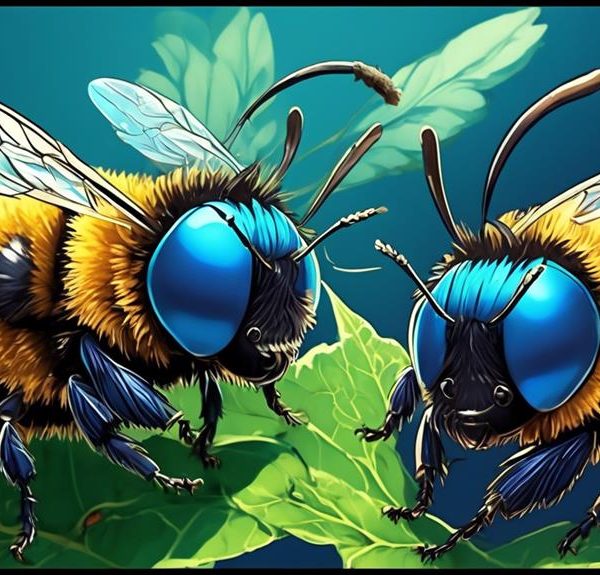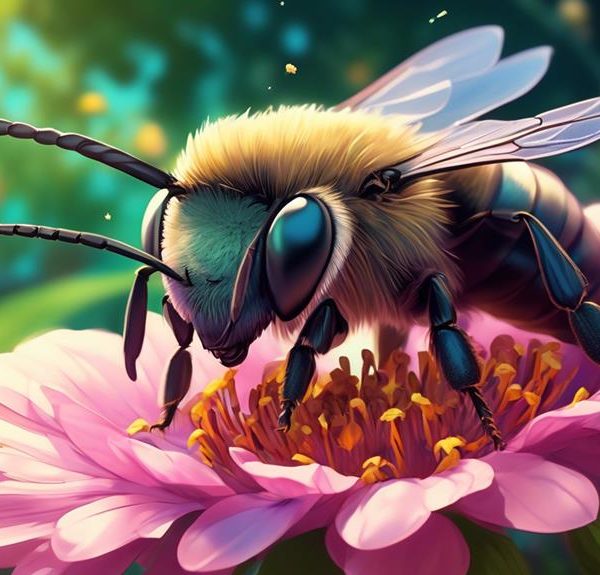Are mason bees and sweat bees the same? Uncover the intriguing differences and the crucial roles they play in our ecosystem.
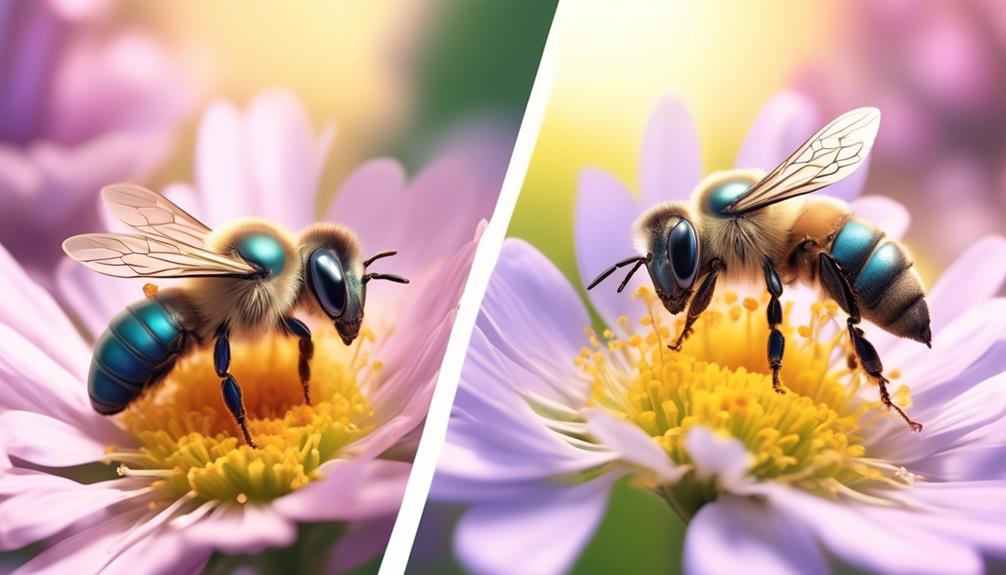
Are Mason Bees and Sweat Bees the Same Bug
You might think all small, buzzing insects you encounter in your garden are the same, but it's not the case. Take, for example, mason bees and sweat bees. Despite their similar size and coloration, they're entirely distinct species, each with unique behaviors and roles in our ecosystems.
Now, you may wonder how to differentiate between these two and why it even matters. Well, stick around, and we'll unravel this entomological mystery together, shedding light on the significant contributions these tiny creatures make to our environment.
Key Takeaways
- Mason bees and sweat bees are different species of bees with distinct characteristics and behaviors.
- Mason bees are solitary insects that build nests using mud, while sweat bees can be solitary or social and nest underground.
- Mason bees are larger in size and more efficient pollinators compared to sweat bees.
- Both mason bees and sweat bees play crucial roles in the environment by pollinating plants and contributing to soil health.
Understanding Mason Bees

You mightn't know it, but there's a good chance you've encountered mason bees, industrious solitary creatures recognized for their exceptional pollinating abilities, in your own backyard. Unlike their more social honeybee counterparts, mason bees are solitary, each female making her own individual nests. They're named for their unique habit of using mud to build these nests, much like a mason would use mortar.
Now, you're probably wondering why these tiny critters matter. Well, according to research, mason bees are considered super pollinators. They're known to visit up to 1600 flowers in a day, making them more efficient than honeybees. When they visit these flowers, they collect pollen on their furry bellies, which is more exposed than that of honeybees, leading to more effective pollination.
Moreover, mason bees are less aggressive than honeybees. They don't have colonies to defend, so they're less likely to sting unless absolutely necessary. This makes them the perfect neighbors for your backyard, contributing to the health of your garden without posing a significant threat.
Understanding these aspects of mason bees can provide insights into their importance in our ecosystem.
The Life of Sweat Bees

While mason bees are fascinating in their own right, it's equally interesting to explore the life of sweat bees, another group of pollinators that play a significant role in our ecosystem. Sweat bees have a life cycle that comprises four stages: egg, larva, pupa, and adult. They're solitary insects, meaning each female sweat bee operates independently.
Below is a table detailing the life stages of sweat bees:
Stage | Duration | Activity |
|---|---|---|
Egg | 2-3 days | Female lays egg in a cell with pollen and nectar |
Larva | 5-10 days | Eats provided food and grows |
Pupa | 2 weeks | Develops into an adult in the cell |
Adult | Several weeks | Females forage, mate and lay eggs |
Sweat bees are named for their attraction to human sweat, which they use as a source of salt. They're generally harmless, but can sting if provoked. Their sting, however, is less painful than that of other bees. Understanding the life of sweat bees helps to appreciate their role in the environment, and their importance as pollinators.
Differences Between Mason and Sweat Bees
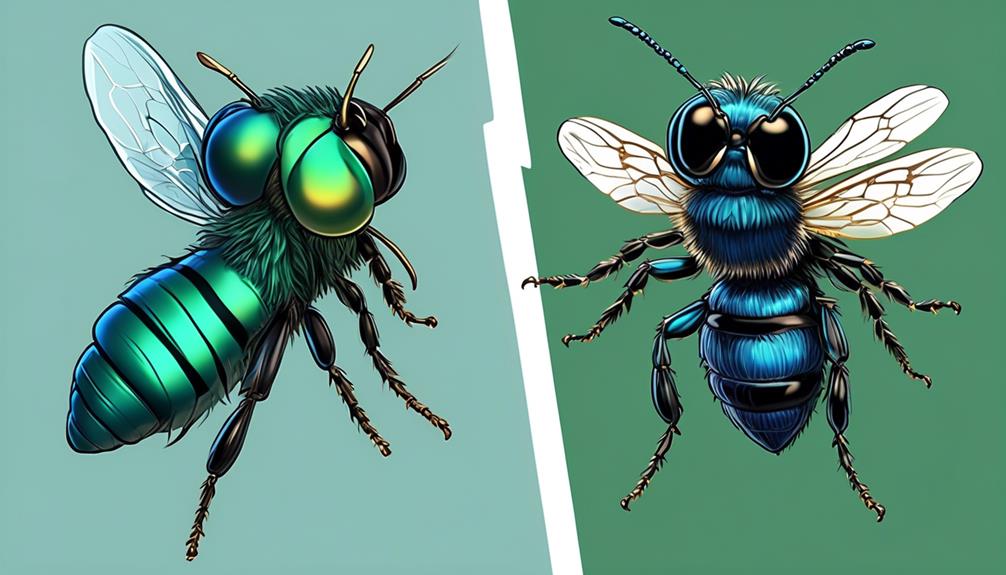
Although Mason and Sweat bees share some similarities as pollinators, they exhibit distinct differences in their behavior, nesting habits, and physical characteristics.
Mason bees, for instance, are solitary creatures. Each female builds and provisions her own nest, usually in hollow reeds or holes in wood. They're also non-aggressive and rarely sting. They're known for their metallic blue or greenish hue and their efficient pollination skills.
On the other hand, Sweat bees, despite their smaller size and less flashy appearance, are social insects that live in colonies. Their nests are typically built underground and they're known to be attracted to human sweat, hence their name. They exhibit a variety of colors, from metallic green to dull brown or black. Contrary to Mason bees, they can be somewhat aggressive if disturbed.
It's also worth mentioning that Mason bees are more efficient pollinators than Sweat bees. One Mason bee can do the work of 100 honeybees in terms of pollination. Sweat bees, however, are still valuable in pollination, particularly in certain crops and wildflowers.
Identifying Mason Bees Vs Sweat Bees
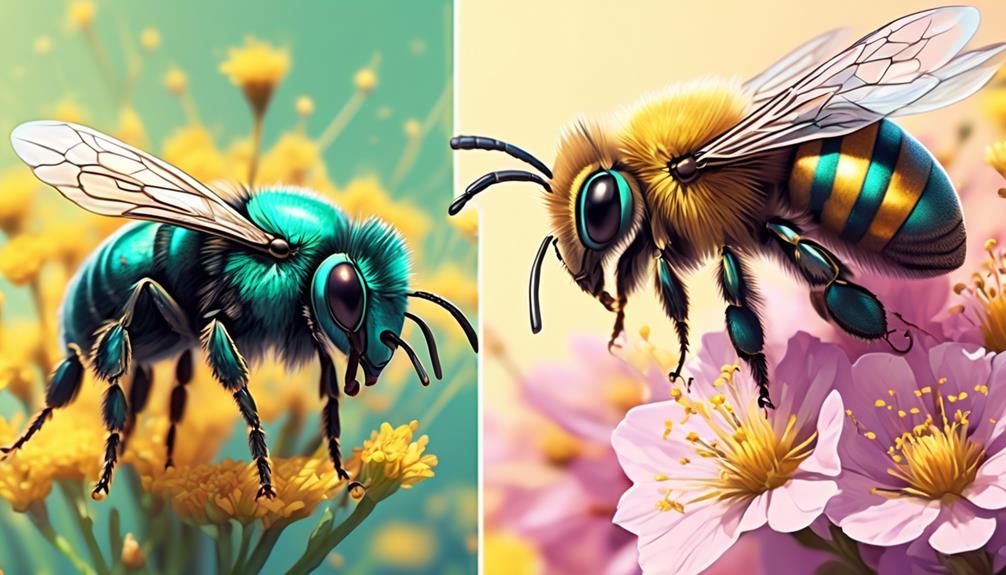
To accurately identify whether you're observing a Mason bee or a Sweat bee, it's important to consider several key characteristics such as their color, behavior, and nest location.
Mason bees, for instance, are often metallic blue or green, while Sweat bees can range from black to metallic green or copper.
In terms of behavior, you'll notice that Mason bees are solitary, meaning they live alone and don't form colonies. Sweat bees, on the other hand, can be either solitary or social, with some species forming colonies.
The nest location of these bees also differs. Mason bees typically nest in small cavities, like hollow stems or holes in wood. They're known for using mud to seal off their nests, hence their name. Sweat bees, however, often nest in the ground, although some species can nest in wood.
Size can also be a differentiating factor. Mason bees are larger, around the size of a honey bee, whereas sweat bees are generally smaller.
The Role of Mason Bees in Ecosystem

Having understood the characteristics that set Mason bees apart from Sweat bees, it's crucial to recognize the significant role they play in our ecosystem. Mason bees, though small in size, are mighty pollinators. They're known to be more effective at pollination compared to honey bees as they carry pollen on their abdomen, which has more direct contact with flowers.
Research shows that Mason bees are solitary creatures, meaning they don't live in colonies like honey bees. This behavior greatly impacts the robustness of our ecosystem as it reduces the risk of disease spread that could ravage large colonies.
Additionally, their nesting habits contribute to soil health. Mason bees lay their eggs in narrow holes, often in wood or hollow stems. After laying an egg, they seal it off with mud, hence their name. This process aids in soil aeration and nutrient distribution.
In essence, you can think of Mason bees as tiny ecosystem engineers. They not only help plants reproduce through pollination but also contribute to soil health, thereby playing a critical role in maintaining biodiversity. Therefore, it's essential to create environments that support their survival.
Sweat Bees' Contribution to Environment
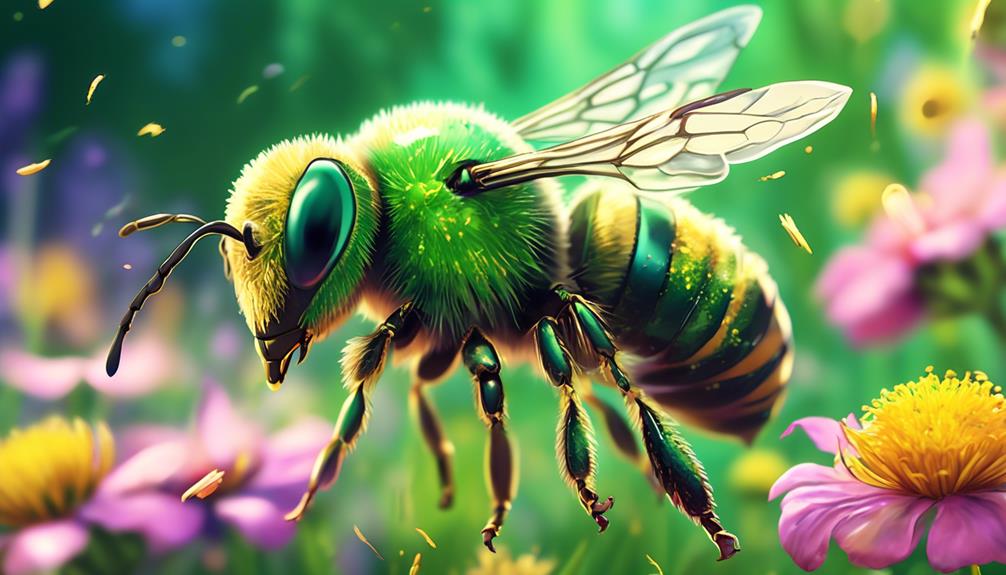
Just like their Mason bee counterparts, Sweat bees are vital mini-architects of our ecosystem, making significant contributions to our environment through their pollination activities and unique behaviors. You'll find these little powerhouses in various ecosystems around the globe, working diligently to sustain plant life.
Although they're small, Sweat bees' impact on our environment is massive. They're key pollinators for many types of flowers and crops. Their constant foraging spreads pollen and fertilizes plants, which is a critical process in seed and fruit production. Without their tireless efforts, you'd see a noticeable drop in plant diversity and food crop yields.
Moreover, Sweat bees play a significant role in soil aeration. They burrow into the ground to nest, which improves the soil's health and fertility. This behavior positively affects plant growth and contributes to the overall health of our ecosystems.
Research has shown that the decline of bee populations, including Sweat bees, could have severe implications for our environment. So, it's essential to understand their role and work towards their conservation. Their contribution goes beyond honey production; they're indispensable to maintaining biodiversity and food security. They're not just bugs; they're environmental superheroes.
Frequently Asked Questions
What Is the Geographical Distribution of Mason and Sweat Bees?
You're investigating the geographical distribution of Mason and Sweat bees.
Mason bees are found worldwide, particularly in North America and Europe. They're especially common in temperate environments.
Sweat bees, on the other hand, are globally distributed, but they're most commonly found in the Northern Hemisphere.
Both bees have adapted to various environments, making them quite versatile.
Are Mason and Sweat Bees Harmful to Humans?
No, mason bees and sweat bees aren't harmful to humans. They're non-aggressive and unlikely to sting unless threatened. Their sting is also less painful than a honeybee's.
However, like with any bee, some people may have allergic reactions. It's important to remember, both types are beneficial pollinators, aiding in plant reproduction.
Can Mason and Sweat Bees Be Kept for Home Beekeeping?
Yes, you certainly can keep both mason and sweat bees for home beekeeping. They're known for being non-aggressive and great pollinators.
Mason bees are especially beneficial for fruit trees and plants. However, they require specific care, like mud for their nests.
Sweat bees, on the other hand, are more versatile, but they're attracted to sweat, which can be a nuisance.
What Are the Common Predators of Mason and Sweat Bees?
You're wondering about the common predators of mason and sweat bees. Well, both types of bees have various predators.
Birds, spiders, and some insects like wasps and flies are known to prey on them. Additionally, mason bees are often targeted by parasitic insects. Sweat bees, on the other hand, can fall victim to robber flies and certain beetles.
It's a tough world out there for these little pollinators!
How Does Climate Change Affect the Populations of Mason and Sweat Bees?
Climate change is impacting mason and sweat bees significantly. Warmer temperatures cause early spring emergence, disrupting the synchronization with their food plants. It's also reducing their habitats.
Prolonged droughts can cause food scarcity and increased mortality. Conversely, more intense rainfall can flood their nests. You see, they're highly sensitive to these changes, so their populations are declining.
It's important that you understand the dire situation these valuable pollinators are in.
Conclusion
So, you've learned that mason bees and sweat bees aren't the same critters. They've distinct differences in life cycles, appearances, and roles in the ecosystem.
Mason bees are master pollinators while sweat bees are versatile in their pollination efforts. Both are irreplaceable in their environmental contributions.
Understanding these differences can help you better appreciate these tiny, hardworking insects and their crucial role in our world.

